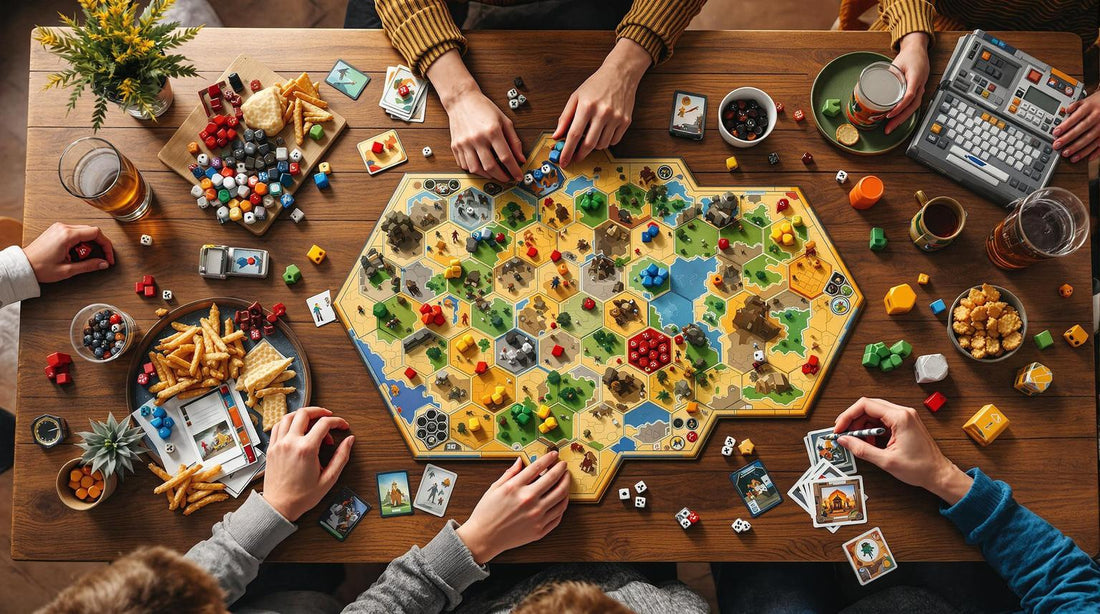Discover the Best Board Games for Every Player

How to Adjust Board Game Setup for 2-6 Players
Struggling to tweak your favorite board game for different group sizes? Here's a quick guide to help you adjust game setups for 2 to 6 players while keeping things fun and balanced:
- Player Count Impacts: Changes in player count affect turn duration, resource distribution, and game flow.
- Common Problems: Issues like extended playtime, strategy imbalance, or unfair starting positions can arise.
-
Key Adjustments:
- Scale resources and adjust board size.
- Modify turn structure to reduce downtime.
- Adjust scoring and game length for fairness.
- Testing Changes: Playtest with different group sizes and gather feedback to refine your setup.
Whether you're scaling a 6-player game for 2 people or expanding a 2-player game for a larger group, these tips ensure an enjoyable and balanced experience.
Read on for detailed solutions and examples to make your game nights smoother!
How Can You Adjust Your Strategy Based on the Number of Players?
How Player Count Changes Games
Player count has a big impact on how board games play out, affecting mechanics, pacing, and overall experience. For instance, 65% of the top 100 board games on BoardGameGeek are multiplayer free-for-all games, while 20% are designed specifically for two players. This breakdown shows why it's important to consider how player count influences gameplay.
Effects on Game Flow
The number of players can change several key aspects of a game:
- Turn Duration and Downtime: In worker placement games, having six players instead of three can significantly increase the time between turns. Designer Uwe Rosenberg notes that extended turn times can disrupt carefully planned strategies when opponents make unexpected moves.
- Resource Distribution: Games like Brass: Birmingham adjust resources and even the playable map area based on the number of players. For example, with two players, part of the northern map is removed to ensure competitive balance.
These changes can sometimes create challenges that need to be addressed.
Common Problems to Fix
Here are some common issues caused by varying player counts and possible solutions:
| Problem | Impact | Solution |
|---|---|---|
| Extended Play Time | More players can drastically increase game length | Scale the end-game timer to match player count |
| Strategy Imbalance | Certain strategies may become too strong or weak | Adjust resources and action spaces |
| Position Advantage | Starting positions might provide unfair benefits | Tweak board layout or starting resources |
- Direct Interaction Issues: Two-player games often require a different design approach. With only one opponent, every aggressive move can be directly countered, which shifts the balance and changes the strategy.
To keep things running smoothly, use tools like reference cards and clear iconography to streamline turns. Keep decisions meaningful and avoid overwhelming players with unnecessary complexity.
Now that we've covered gameplay flow and common pitfalls, let’s look at how game pieces can be adjusted to improve balance.
Adjusting Game Pieces
Tweak game components to match the number of players while keeping the gameplay fair and balanced. This includes adjusting starting resources and modifying the board size.
Starting Resources
Set up starting resources to ensure a fair balance. For smaller groups, reduce resources to maintain a sense of scarcity. In games with more players, consider increasing resources slightly so everyone has enough to develop meaningful strategies. Make sure there are enough workers to support a variety of approaches. Afterward, adjust the board size to further refine the balance.
Board Size Changes
Changing the board layout is key to keeping the game competitive and engaging. These adjustments should align with earlier changes to maintain smooth gameplay. Use official expansion guidelines when scaling the board. For example, the Spirit Island: Jagged Earth expansion offers "standard" layouts for 5–6 players, ensuring territories are distributed fairly.
For larger groups, refer to the official rules or expansions for the best board setup. In CATAN, playing with 5–6 players requires the base game extension to accommodate the extra participants. For modular boards, adjust the configuration to encourage meaningful player interaction.
Card and Tile Numbers
To complement changes in resources and board layout, adjust the number of cards and tiles to keep the game balanced. Scale them based on the player count while maintaining their original ratios and mechanics. Keep the proportions of card types consistent, and for larger groups, consider tweaking hand sizes to prevent decision fatigue. Similarly, adjust the number of tiles systematically to maintain strategic depth and game flow.
sbb-itb-1ed942f
Changing Game Rules
Once game pieces are refined, tweaking the rules can help ensure balanced gameplay for groups of various sizes. Adjustments should account for the number of players while keeping the core mechanics intact.
Turn Structure
Reduce downtime by organizing turns more effectively. Techniques like double-sided tokens, dual initiative tracks, or fixed sequences based on attributes can help keep the game moving smoothly.
For larger groups (5–6 players), try the Popcorn Initiative system. In this setup, the current player chooses who goes next. This approach not only reduces waiting time but also adds a layer of strategy to the turn order.
Point Systems
Scoring adjustments are key to maintaining fairness across different player counts. The aim is to keep the average points-per-player consistent so rankings remain equally challenging, no matter the group size.
Here are some scoring tweaks to consider:
- For smaller groups (2–3 players), increase individual point values to emphasize meaningful score differences.
- For larger groups (4–6 players), adjust the scoring curve to better distribute points.
- Balance the system to reward both individual and group efforts without letting cooperative elements overshadow personal achievements.
When calculating final scores, focus on each player's top performances to maintain competitive fairness.
Game Length
Keep game duration balanced. For 2–3 players, stick to the standard length. For 4–6 players, consider using simultaneous actions or equal-turn systems to ensure the game stays fast-paced without sacrificing decision-making opportunities.
Testing Your Changes
Once you've adjusted the game pieces and rules, it's time to test your setup thoroughly. This means trying it out with different player counts and using feedback to fine-tune your changes.
Practice Games
Run test games with varying numbers of players (from 2 to 6) to identify any problems. Track important details like how long the game takes, how much downtime players experience, win/loss patterns, and how resources are distributed. Pay close attention to players' body language - confusion or frustration can often show up in their expressions or actions.
"I believe 75% of what I take from playtests is learned from observations... Most of these things don't come from the verbal or written feedback they provide afterwards, although that does provide its own value."
These observations will help you focus on the right areas when gathering player feedback.
Player Comments
Player feedback is essential for refining your game. Use a structured approach, like the "Goldilocks scale", to evaluate different elements of the game:
| Aspect | Too Little | Just Right | Too Much |
|---|---|---|---|
| Player Interaction | Limited engagement | Balanced exchanges | Overwhelming chaos |
| Resource Access | Scarcity issues | Fair distribution | Excess resources |
| Turn Length | Rush decisions | Comfortable pace | Analysis paralysis |
"Ultimately, I ensure that each play-test session has a very specific purpose. If I'm worried about a particular player strategy I will ask one of the play-testers to focus their strategy on that. The goal being to see if the strategy is actually dominant or if my hypothesis is unfounded."
This targeted approach ensures you address potential issues effectively.
Writing Down Rules
Once you're confident in your changes, write the rules clearly and concisely. Use diagrams and examples to make them easy to follow.
"When writing rules, you need to clearly understand and feel how that player may be feeling in the situation you're writing for."
To test your written rules, give them to new players and see if they can set up and play the game without additional guidance. This step ensures your instructions are clear and user-friendly.
Final Tips
Here’s how you can tweak your game to keep it balanced and fun, no matter how many people are playing:
| Player Count | Key Adjustments | Common Pitfalls |
|---|---|---|
| 2 Players | Add a virtual third player or use special rules | Too much direct conflict can dominate |
| 3-4 Players | Stick with the standard setup, with minor tweaks | Imbalanced resource distribution |
| 5-6 Players | Reduce components and speed up turns | Longer waiting times between turns |
These tweaks help maintain a smooth and engaging gameplay experience.
When making changes, focus on keeping the core feel of the game intact while adjusting for the number of players. Game designer Thibault Schönmann explains it well: "In a 6-player game, each player will do less than in a 2-player game, so they'll have to focus on shorter-term efficiency. The result is a different experience of playing the same game."
Here are a few key adjustments to consider:
- Simultaneous Actions: Let players act in parallel during certain phases to reduce downtime.
- Resource Scaling: Start players with resources that match the group size.
- Board Modifications: Shrink the board for smaller groups to encourage more interaction.
"I use equal turns to maintain a consistent experience across different player counts." - Frank West
You might also want to check out games specifically designed for flexible group sizes. Brain Games, for example, offers options that work well with different player counts. The ultimate goal? Keep the game strategic and engaging for everyone. Always test your adjustments and gather feedback to fine-tune the experience.






